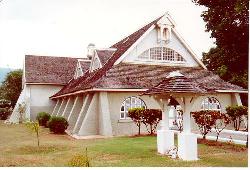|
Welfare Brief History of
Garrison Church
Brief history of the Garrison Church Little is known of the old school chapel which existed before the great earthquake of 1907 except that this building, together with a number of others was destroyed. After the restoration of the barracks, Hut number 14 was used for worshipping until Ascension Day 1912. On this day the Garrison Church as we know it today was dedicated to Divine Service by the late Archbishop of the West Indies, the Most Reverend Enos Nutall, in the presence of the then Governor, Sir Sydney Oliver, KCMG, the General Officer Commanding, Brigadier-General J.R.M. Dalrymple-Hay CB., DSO., and other dignitaries and officers. The form of the service used for the dedication was one specially approved by the War Office and was followed by shortened Evensong.
The church is built just outside the entrance to the main guardroom of Lathbury Barracks and immediately opposite to the Obelisk erected in memory of those officers, men and families who perished in the great calamity of 1907. It was built by S.R. Eustace Fielding Esq., and the work was supervised by Lieutenant Colonel R. Carey Commander Royal Engineers and Major B.F. Caws, R.E. while QMS V. Sponsor was the military foreman of works. Incidentally, the late Miss Phyllis Caws, daughter of Major Caws, maintained a constant link with the church up to the time of her death on 4 January 1968. She was for many years Sunday school teacher. Miss Caws’ funeral service was held in the church with which she was connected for over fifty years. The cost of the present building was between five and six thousand pounds and it was erected to accommodate about five hundred people. The style is said to be Jacobean and the plan cruciform. It is approximately 120 feet in length and 62 feet across the transept. The fittings are of local cedar and the altar cross in use today was a gift from the Garrison Church in Portsmouth in 1905. This was about the only furnishing rescued from the old school chapel after the earthquake. The floor of the Chancel and the Sanctuary is of simple mosaic design. The remainder of the floor was of pine and teak block laid in herringbone fashion on a concrete base. This has now been replaced with a simple concrete floor. The massive reinforced concrete walls are bound together on a steel frame resting upon deep and strong foundations. While the exterior gives the impression of solidity and strength; the beauty of the interior is most striking. The lines are good and the symmetry of the whole is perfect. The ceiling consists of a series of arches culminating in the main arch resting on concrete columns with Ionic capitols at the transept and chancel. In 1953 part of the southern transept was converted into a children’s chapel. It was dedicated to the memory of those soldiers and families, most of whom were children, who were lost at sea in an air trooper on their way from the United Kingdom to Jamaica. "The Church, although primarily used by Anglicans, has been used by all other denominations including Roman Catholics both for normal worship as well as other religious ceremonies." At its dedication the Archbishop said "a place for worship separated from common usage gives expression to a recognition of the reverence due to the almighty – and also fits in with the needs and requirements of human nature". This church in its beautiful surroundings bears this out. The above article was written by Lieutenant Colonel R.G. GREEN and published in a past Alert magazine. |
 The service of
dedication was conducted by the Anglican Chaplain, the Reverend A.C.E. Jarvis, the
Reverend W. Patt M.A., of the Baptist Church read the first lesson. The Reverend J.F.
Gartshove M.A., of the Presbyterian Church read the second lesson and the Reverend J.W.
Wright of the Methodist Church said prayers. At this service the Colours of the First,
Second and Third Battalions of the West India Regiment, formerly kept at the Kingston
Parish Church, were handed over by a Guard of one hundred officers and men for safe
keeping in the new church. In addition, the Colours of the Jamaica Battalion presented in
1943 are laid up in the church. These Colours were used by the West India Regiment 1959 –
1962 and the Jamaica Regiment from 1962 until the presentation of their own Colours in
1963. The first standard of the Jamaica Legion (BESL) has also been laid up in the chapel
since 1967.
The service of
dedication was conducted by the Anglican Chaplain, the Reverend A.C.E. Jarvis, the
Reverend W. Patt M.A., of the Baptist Church read the first lesson. The Reverend J.F.
Gartshove M.A., of the Presbyterian Church read the second lesson and the Reverend J.W.
Wright of the Methodist Church said prayers. At this service the Colours of the First,
Second and Third Battalions of the West India Regiment, formerly kept at the Kingston
Parish Church, were handed over by a Guard of one hundred officers and men for safe
keeping in the new church. In addition, the Colours of the Jamaica Battalion presented in
1943 are laid up in the church. These Colours were used by the West India Regiment 1959 –
1962 and the Jamaica Regiment from 1962 until the presentation of their own Colours in
1963. The first standard of the Jamaica Legion (BESL) has also been laid up in the chapel
since 1967.